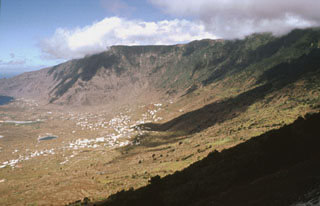Report on Hierro (Spain) — 12 October-18 October 2011
Smithsonian Institution / US Geological Survey
Weekly Volcanic Activity Report, 12 October-18 October 2011
Managing Editor: Sally Sennert.
Please cite this report as:
Global Volcanism Program, 2011. Report on Hierro (Spain) (Sennert, S, ed.). Weekly Volcanic Activity Report, 12 October-18 October 2011. Smithsonian Institution and US Geological Survey.
Hierro
Spain
27.73°N, 18.03°W; summit elev. 1500 m
All times are local (unless otherwise noted)
Instituto Geográfico Nacional (IGN) reported that tremor, registered by every seismic station on El Hierro Island, continued during 12-18 October. Deformation decreased during this period, with significant inflation-deflation episodes registered by the stations located in the NW part of the island. On 12 October, at about 1430, the amplitude of the tremor signals abruptly decreased and smaller amplitudes persisted during the following days. During the afternoon of 12 October a large light-green colored area was observed in the sea to the S of La Restinga village (at the southernmost point of Hierro); the evolution of this anomaly was observed from land and by helicopter. The extension of the anomaly was controlled by the ocean currents, but a small area was detected as the emission center due to its intense discoloration and concentration. During a helicopter flight on 15 October, steamy lava fragments in this small area were observed. In the same area, during 15-17 October, frequent episodes of emission, forming big turbulent rings of gas and foaming, were observed on the sea surface. Since the night of 17 October, the amplitude of the tremor signal had decreased slowly. On 18 October, deformation further decreased and the sea-surface disruption from gases was not observed.
Geological Summary. The triangular island of Hierro is the SW-most and least studied of the Canary Islands. The massive shield volcano is truncated by a large NW-facing escarpment formed as a result of gravitational collapse of El Golfo volcano about 130,000 years ago. The steep-sided scarp towers above a low lava platform bordering 12-km-wide El Golfo Bay, and three other large submarine landslide deposits occur to the SW and SE. Three prominent rifts oriented NW, NE, and S form prominent topographic ridges. The subaerial portion of the volcano consists of flat-lying Quaternary basaltic and trachybasaltic lava flows and tuffs capped by numerous young cinder cones and lava flows. Holocene cones and flows are found both on the outer flanks and in the El Golfo depression. Hierro contains the greatest concentration of young vents in the Canary Islands. Uncertainty surrounds the report of an eruption in 1793. A submarine eruption took place about 2 km SSW off the southern point of the island during 2011-12.

